Zotac ZBOX: Brazos Goes HTPC
by Andrew Van Til on June 9, 2011 5:00 PM ESTAudio and Video Formats and Options
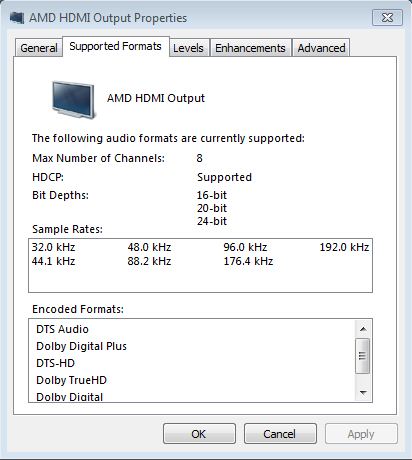
AMD was the first to add HD audio support to its discrete GPU lineup, but limited its integrated solutions to S/PDIF like performance (stereo PCM and Dolby Digital/DTS bitstreaming). The Fusion family of APUs changes that, with their integrated HDMI audio solution finally matching the feature set introduced in Intel’s previous generation “Clarkdale” IGP. HD bitstreaming was tested with the currently available versions of commercial BD players including CyberLink PowerDVD 10/11, Corel WinDVD 2010, and Arcsoft Total Media Theatre (TMT) 5. We also tested with the FOSS DirectShow filters ffdshow and LAV Audio. Each option performed as expected, with the exception of the current “gold” release of TMT (5.0.1.87); that requires a patch, scheduled for release in early June, to bitstream HD formats. Multi-channel LPCM is supported, so that is a lossless workaround available to current owners. It should be noted, however, that like many other PC platforms, audio intended for the left/right surrounds is incorrectly mapped to the left/right rear surrounds when playing 5.1 content in a 7.1 configuration.
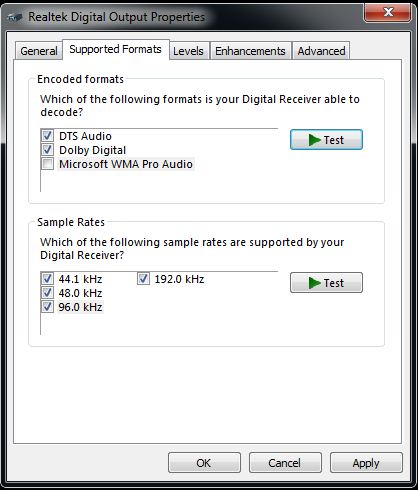
Rounding out the audio options, the ZBOX also includes an optical S/PDIF (TOSLINK) output on the system for those without an HDMI equipped AVR. The TOSLINK provides Dolby Digital, DTS, WMAPro, and stereo PCM. WMAPro requires support from the AVR, which the Denon AVR-1909 used in testing does not provide.
The AD03BR-PLUS-U was tested with an HDMI equipped Panasonic TC-P58VT25 plasma and an older Samsung HLN437W DLP via DVI. Both displays were properly detected when connected, with the correct resolution/refresh rates available in the configuration utility. If your HDTV has missing resolutions, it should be possible to add them using the screen displayed above.
Like all rear-projection TVs, the Samsung DLP does not have a 1-to-1 pixel mode, so 1280x720 (720p) displays with a slight overscan. AMD provides the ability to create a custom resolution, found lower down the same configuration screen, and it’s very easy to use for those who want to make the entire desktop visible.
Unfortunately, AMD assumes that every display is not set to natively map pixels (which to be fair, most TVs do not by default), so the first time it was connected to the Panasonic the opposite correction was required. Interestingly, this setting must be set per refresh rate. When switching from 59Hz to 23Hz before watching a movie I had to adjust it a second time.
![]()
The default pixel format when connected via HDMI is YCbCr 4:4:4 (10-bit), which was good because it was the only format where levels could be made consistent across every application without using RGB Full (0-255). That requires specific calibration, making it unsuitable in situations where the input must be shared with a non-RGB full device. The driver does not display this setting for DVI users so RGB Full is used.
All of the commercial players operating in disc mode (i.e. physical disc, BDMV, or ISO playback) output correctly with YCbCr or RGB, but file mode was inconsistent when YCbCr 4:4:4 or RGB Full was not set. These results are in line with what was experienced with Enhanced Video Renderer (EVR) based applications like Windows Media Center, SageTV and MPC-HC. These only output correct video levels (16=black, 235=white) when the application forces PC levels (0-255) internally, something that requires two conversions for video content unless using RGB Full output.
Each of the EVR based applications listed previously has a setting to enable 0-255 output, with MPC-HC’s being the easiest (a simple toggle in the user interface). Windows Media Center and SageTV require the registry changes below:
- Windows Media Center: HKLM\SOFTWARE\Debug\ehPresenter.dll, NominalRange (DWORD) = 1
- SageTV: HKLM\ SOFTWARE\Frey Technologies\SageTV\DirectX9, EVR0To255Range (DWORD) = 1
Historically, AMD has provided the best level of refresh rate precision by default, but unfortunately that is not the case with the E-350’s 6310. As you can see from the pictures and video tracking accuracy for 24p content, it certainly can hit the target, but it has issues maintaining the correct frequency over time. In most cases, the drift was not bad enough to notice, but at times audio/video sync was an issue for brief periods.


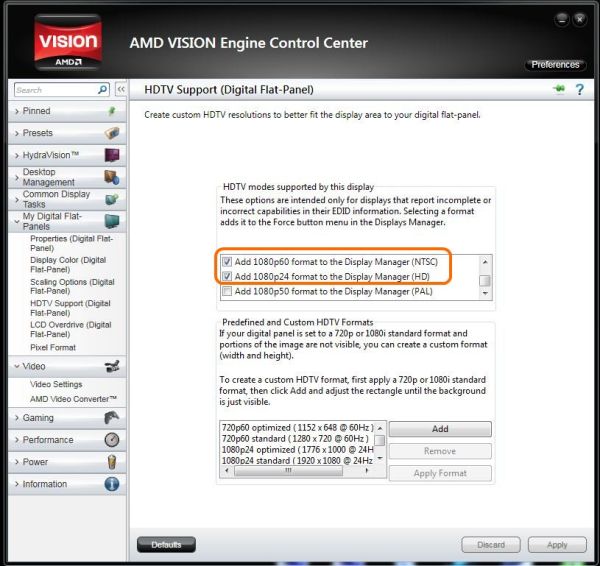
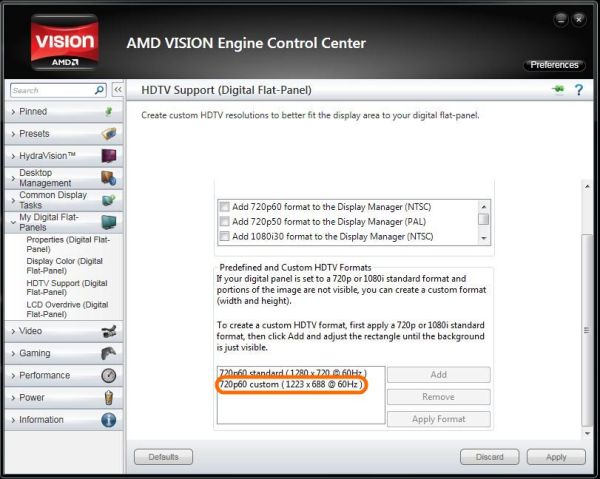
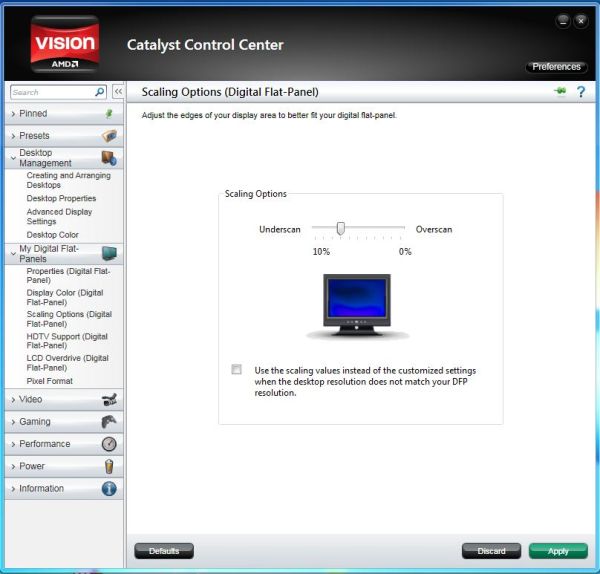
















36 Comments
View All Comments
cjs150 - Friday, June 10, 2011 - link
Every time a new HTPC comes out we get closer and closer to an ideal main room solution. Sure it is not a gaming rig, but for watching media, maybe doing some web browsing and emails it looks good. However there are 3 or 4 areas which need work:1. Built in IR remote, absolutely essential and needs to have ability to shut off/sleep and bring back the machine to live
2. Noise. We are never going to get total silence (probably) with this size of case but I am worried about Andrew's comment in the article. Cannot help but conclude that a slightly larger case and a slow running fan might be a better combination.
3. Noise (2). I have a high end AV rack but the thing that bugs me is the Blu-ray player (Onkyo). In the quiet sections of movies I can hear the player. Crucial therefore is the noise of the slim line player in the ZBOX. Is it properly isolated/dampened from rest of case
4. TV cards. I know you can get USB TV tuners but quality never seems to be as good as internal cards. Again given the size of the ZBOX I can forgive this not being included (and the cable set top box can do this for me) but would be on my wish list as the perfect HTPC.
5. Finally picture quality. Always subjective but what worried me is the "drifting" Andrew reported. Intel cannot play 24 fps movies at the absolute correct frame rate (which is not exactly 24 fps), AMD can... or at least I thought that was the case until reading this article. "Drifting" worries me, but maybe improved drivers will help.
Now can I have one in pure black to match the rest of the AV rack please!
burntham77 - Friday, June 10, 2011 - link
All great ideas.Using Brazos inside a larger case that would allow the use of the one PCIe slot would allow for a PCIe CableCard tuner, or if you just wanted local channels an HDHomerun works too. A larger case (like my Antec Fusion Remote Black) allows for better airflow and a quieter system (I never hear mine even when it's spinning a blu-ray disc).
My only real concern with moving to a Brazos setup from my Athlon X2 is your fifth item, about image quality. Although my only real concern is with Netflix. Until Silverlight adds GPU acceleration, I guess I can switch over the Xbox 360 if I need Netflix.
Despite the concerns, this is another article has brought me that much closer to this setup.
jaydee - Friday, June 10, 2011 - link
Nice review overall!An Atom-based HTPC should have been included for comparison. Something like this guy, that AT has already reviewed: http://www.anandtech.com/print/4081
I think it's important in reviews to consider what is underneath your test article, as well as what is higher performing, for balance purposes. Not to mention that Brazos is sort of the natural upgrade path from Aom/ION in the low-power HTPC segment.
babgvant - Friday, June 10, 2011 - link
I agree that an ION system would have made a great additional data point. Unfortunately I don't have one on hand, but I did have a first gen ZinoHD so it was included as a reference (with some very interesting results).bhigh - Friday, June 10, 2011 - link
Most people I know use Linux and XBMC for their HTPC.It would be nice to know how the E350 supports this.
Penti - Saturday, June 11, 2011 - link
While technically possible XBMC's stable release do not support it and it's not trouble free to get it to work with hardware acceleration on the distro side with the development version of XBMC since you need it to go through libva/vaapi with xvba backend so it wouldn't workout of the box. It would also be quiet pointless with a blu-ray system and running Linux where you won't get it to work (cleanly) and even most of (your normal) illegal ripping tools do not work. Neither does XBMC support blu-ray on Windows without launching something like PowerDVD.djkebhri - Friday, June 10, 2011 - link
Anand,I have an issue with this quote at the bottom of page 3:
"Historically, AMD has provided the best level of refresh rate precision by default, but unfortunately that is not the case with the E-350’s 6310. As you can see from the pictures and video tracking accuracy for 24p content, it certainly can hit the target, but it has issues maintaining the correct frequency over time."
This is incorrect. I assure you, there is nothing wrong with the E-350 and/or the 6310 playing 23.976 or 24 fps content when Catalyst is properly set to that mode.
I have an ASUS E35M1-M Pro connected to my Samsung LN40C630 and it has no issues. Any issues you have are not due to AMD. They might be from an issue in the test setup, equipment, or the Zotac itself.
ganeshts - Friday, June 10, 2011 - link
The experience with AMD cards for 23.976 Hz refresh rate varies across different systems and setups. Unless AMD provides a way for the end user to tweak the refresh rate according to the setup, I wouldn't consider it as reliable 23.976 at all.Slaimus - Friday, June 10, 2011 - link
How come a complete E-350 laptop like the dm1z or X120e can be bought for under $400 but a box like this is over $500? The LCD/battery/keyboard/touchpad should outweigh the price of a BD reader upgrade.jaydee - Friday, June 10, 2011 - link
Volume maybe? Laptop makers buy everything in much higher volumes than Zotac buys HTPC components. I don't know if this alone makes the difference or not. Maybe Zotac is pulling a lot higher profit margin?But your logic is valid. Can one just connect a E350 laptop to an HTPC setup and do everything that this unit can do? Minus the blu-ray, which can be added on later?